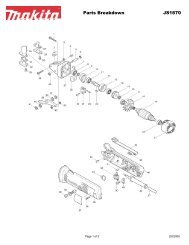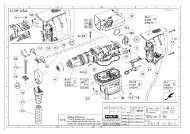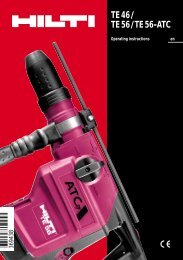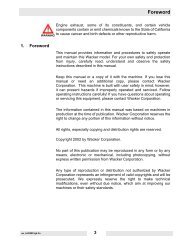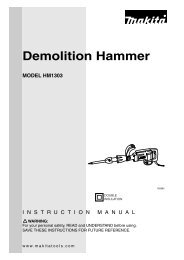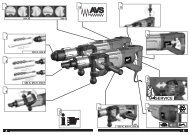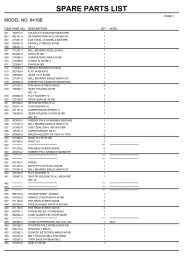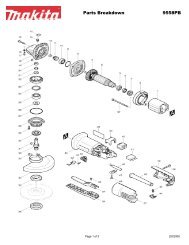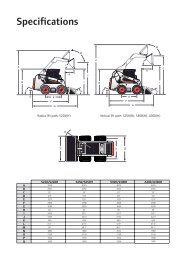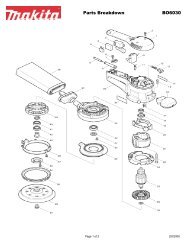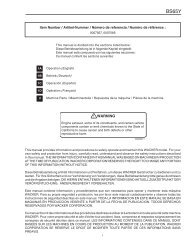Dewalt - DW742 - Electric Flipover Saw
Dewalt - DW742 - Electric Flipover Saw
Dewalt - DW742 - Electric Flipover Saw
Create successful ePaper yourself
Turn your PDF publications into a flip-book with our unique Google optimized e-Paper software.
ENGLISH<br />
• Allow the motor to reach full speed before cutting.<br />
• Raise the blade from the kerf in the workpiece prior to releasing the<br />
switch.<br />
• Do not wedge anything against the fan to hold the motor shaft.<br />
• Never place either hand in the blade area when the saw is connected<br />
to the electrical power source.<br />
• Do not attempt to cut excessively small pieces.<br />
• Never attempt to stop a machine in motion rapidly by jamming a tool or<br />
other means against the blade; serious accidents can be caused<br />
unintentionally in this way.<br />
• Do not use cracked or damaged saw blades.<br />
• Do not use any abrasive discs.<br />
Additional safety rules for saw benches<br />
• Make sure that the blade rotates in the correct direction and that the<br />
teeth are pointing to the front of the saw bench.<br />
• Be sure all clamp handles are tight before starting any operation.<br />
• Be sure all blade and flanges are clean and the recessed sides of the<br />
collar are against the blade. Tighten the arbor nut securely.<br />
• Keep the saw blade sharp and properly set.<br />
• Make sure that the riving knife is adjusted to the correct distance form<br />
the blade - 3-8 mm.<br />
• Never operate the saw without the upper and lower guards in place.<br />
• Keep your hands out of the path of the saw blade.<br />
• Disconnect the saw from the mains supply before changing blades or<br />
carrying out maintenance.<br />
• Use a push stick at all times, and ensure that you do not place hands<br />
closer than 150 mm from the saw blade while cutting.<br />
• Do not attempt to operate on anything but the designated voltage.<br />
• Do not apply lubricants to the blade when it is running.<br />
• Do not reach around behind the saw blade.<br />
Residual risks<br />
The following risks are inherent to the use of this saw:<br />
- Injuries caused by touching the rotating parts<br />
In spite of the application of the relevant safety regulations and the<br />
implementation of safety devices, certain residual risks cannot be<br />
avoided. These are:<br />
- Impairment of hearing.<br />
- Risk of accidents caused by the uncovered parts of the rotating saw<br />
blade.<br />
- Risk of injury when changing the blade.<br />
- Risk of squeezing fingers when opening the guards.<br />
- Health hazards caused by breathing dust developed when sawing<br />
wood, especially oak, beech and MDF.<br />
Package contents<br />
The package contains:<br />
1 Partly assembled machine<br />
4 Legs<br />
1 Top guard for bench saw position<br />
1 Under-table guard for mitre saw position<br />
1 Plastic bag containing:<br />
1 pin spanner<br />
1 Allen key 6 mm<br />
1 Skinpack containing:<br />
1 dual height rip fence (DE3743)<br />
1 push stick<br />
1 30 teeth TCT saw blade<br />
1 Instruction manual<br />
1 Exploded drawing<br />
• Check for damage to the tool, parts or accessories which may have<br />
occurred during transport.<br />
• Take the time to thoroughly read and understand this manual prior to<br />
operation.<br />
• Remove the saw from the packaging material carefully.<br />
Description (fig. A1 - A4)<br />
Your DEWALT flip-over sawing machine has been designed to operate as a<br />
mitre saw or as a saw bench to perform the four main sawing operations of<br />
ripping, cross-cutting, bevelling and mitring easily, accurately and safely,<br />
using the following materials: wood, wood products, aluminium and plastic.<br />
Mitre saw mode<br />
In mitre saw mode, the sawing machine is used in vertical, mitre or bevel<br />
position.<br />
<strong>Saw</strong> bench mode<br />
Turned over on its central axis, the sawing machine is used to perform the<br />
standard ripping operation and for sawing wide pieces by manually<br />
feeding the workpiece into the blade.<br />
A1<br />
1 On/off-switch<br />
2 Side panel<br />
3 Leg clamping wingnut<br />
4 Leg<br />
5 Foot<br />
6 Mitre saw table<br />
7 Fence<br />
8 Rotating table location plunger<br />
9 Fixed lower rear guard<br />
10 Fixed upper blade guard<br />
11 Dust extraction adapter<br />
12 Head lock release lever<br />
13 Blade bolt<br />
14 Outer flange<br />
15 Moving lower guard<br />
16 Rotating table<br />
17 Rotating table clamp<br />
18 Mitre scales<br />
19 Table release lever<br />
A2<br />
20 Control handle<br />
21 Depth stop rod<br />
22 Height adjuster<br />
23 Dust extraction adapter<br />
24 Bevel clamp handle<br />
25 <strong>Saw</strong> table retention bracket<br />
26 Table locking device<br />
27 Riving knife clamp knob<br />
28 Motor housing<br />
<strong>Saw</strong> bench mode<br />
A3<br />
29 Upper blade guard<br />
30 Riving knife<br />
31 <strong>Saw</strong> bench table<br />
32 Mitre fence (optional)<br />
33 Dual height parallel fence<br />
Optional accessories<br />
For use in mitre saw mode:<br />
A3<br />
32 Mitre fence (DE3496)<br />
20 en - 3



